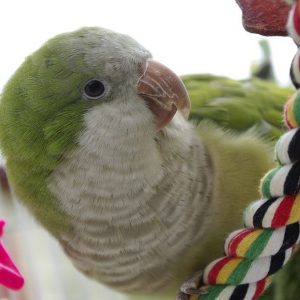Let’s start this article out with a question: How many of you recognize the voice of a loved one? A friend that you’ve known for some time; the sound of your parents’ voices, your children. Each one of them has developed individual vocal patterns and sounds that we know as unique to them. These “signature” sounds are the identifiers for our brains as to who it is we’re recognizing.
Familiarity is a warm thing. As humans, we don’t think about the fact that this is an amazing skill that is part of us. But we do become amazed at the skill when it is displayed by creatures other than ourselves.

A recent biological survey undertaken by the Max Planck Institute of Animal Behavior (Germany) with four scientists (three from Max Planck; one from the Museum of Natural Sciences Barcelona (Spain) set out to determine if Monk Parakeets could recognize exact vocal prints in others of their kind. It would help to create a realization that birds might possibly recognize the ‘voice’ of their close friends, able to accurately identify them in a chorus of other bird calls.
In the study, 229 banded monk parakeets (also known as quaker parakeets) were recorded 5,599 times over a two-year period. The intent was to determine if distinctive vocal patterns occurred across a series of call types, and if it is consistently the same pattern. If so, can it be used to recognize a certain individual parrot by other individual parrots?
The results were amazing if not fully proven (as of yet). What was discovered is that there is evidence that a single parrot produces a unique vocal signature in two out of five call types. In addition, it was determined that individuality in vocal signature was far more variable in individuals than was thought to be evident.
Throughout the study, the scientists look deeper into the realities of the probability of vocal recognition. They recognize that such familiarity can utilize the brain to ponder on decision-making and who to interact with…and stay away from. They understand via previous associative studies that recognition of “voice” can lead a bird to decide to help another, which can lead to benefits not only for the recipient but also for the one responding. Humans have evolved to the point that we not only use sounds to identify threat or friend, we also use facial cues, smells, and other indicators to make a determinant decision to interact.
It is known that other animals produce recognizable variants in sound. For example, the bottle-nose dolphin has specific whistle variants that other dolphins understand when not in visual contact with each other. Various previous studies already understand that birds vary call types (as do bats, and primate species) to alert others.
Birds of all kinds likely learn their specific calls as chicks, changing them as they grow older to coincide with the sounds of a flock. Monk Parakeets are great pets with strong vocal imitation ability. They continue to learn over their lifetimes. Their ability has prompted science to look deeper to determine an ability to recognize each other by ‘voice’. The study believes that they do, in fact, recognize each other, and that they can also create certain dialect by their location.
The study contains complex reviews that go far deeper into the probabilities and the potential impacts of such distinctive vocal patterns and their recognition by other individual Monk Parakeets (test subjects). For a more in-depth review, you can read the actual study here. (The full text is found by selecting a tab.)

7 Comments